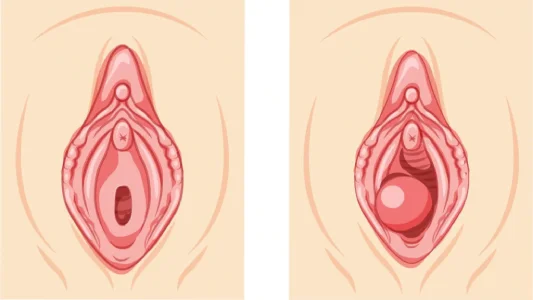What is Bartholin Cyst?

This might sound like a new word, but it isn’t. A Bartholin cyst is more common than you might think, affecting many women worldwide. Despite its prevalence, awareness about this condition is relatively low. Understanding what a Bartholin cyst is, how it develops, and why it matters can help women recognize symptoms early and seek appropriate care.
What Is a Bartholin Cyst?
A Bartholin cyst is a fluid-filled swelling that occurs when one of the Bartholin glands is blocked. These cysts can vary in size, from a small, pea-sized lump to a large, noticeable mass. While some cysts remain small and go unnoticed, others can grow significantly, causing discomfort or pain, especially during activities such as walking, sitting, or sexual intercourse.
Bartholin cysts can develop at any age but are most common in women of reproductive age. The exact cause of the blockage can vary, but it is often due to infection, injury, or inflammation. When a cyst becomes infected, it can form an abscess, which is a painful, pus-filled area that requires prompt medical attention.
Why Should You Know About Bartholin Cysts?
Understanding Bartholin cysts is essential for several reasons:
Recognizing Symptoms Early: Knowing the signs of a Bartholin cyst can help women seek treatment sooner, potentially preventing complications. Common symptoms include a painless lump near the vaginal opening, discomfort during movement or intercourse, and, in cases of infection, pain, redness, and swelling.
Preventing Infection: While not all Bartholin cysts become infected, the risk is present. Awareness of the condition allows women to take preventive measures, such as maintaining good hygiene and seeking medical advice if they notice any unusual symptoms.
Understanding Treatment Options: Treatment for Bartholin cysts varies depending on the size of the cyst and whether it is infected. Small, asymptomatic cysts may require no treatment and can resolve on their own. However, larger or painful cysts might need intervention. Treatment options include warm compresses, sitz baths, antibiotics, drainage procedures, and, in some cases, surgical removal of the cyst.
Promoting Women’s Health: Discussing Bartholin cysts openly contributes to broader conversations about women’s health. Many gynecological conditions go undiscussed due to stigma or lack of awareness. By understanding conditions like Bartholin cysts, women are empowered to take charge of their health and seek appropriate care.

What are the common Bartholin Cyst Symptoms?
👉🏻 Lump or Swelling | 👉🏻 Pain or Discomfort | 👉🏻 Redness and Tenderness | 👉🏻 Painful Walking or Sitting | 👉🏻 Fever | 👉🏻 Difficulty Urinating or Walking
If you’re experiencing these symptoms and reside in Mumbai, you might wonder, “Where can I find the best gynecologist in Mumbai?” One highly recommended professional is Dr. Deepika Doshi, known for her expertise and compassionate care in women’s health. Dr Doshi’s approach ensures that her patients feel comfortable and informed about their health conditions, making her one of the best gynecologists in Mumbai.
What Causes A Bartholin Gland Cyst?
The Bartholin gland cyst occurs when the glands swell, opening up and releasing infection-causing bacteria into the surrounding area. The swelling and bacterial infection in the gland can cause a collection of fluid and pus to form in the space between your vagina and anus, called your perineum.
The cyst occurs when a gland becomes infected, usually by a bacteria called staphylococcus. Other things that contribute to a Bartholin gland cyst include:
- Hormone imbalances.
- Trauma to the area during sex or exercise.
- Friction from tight clothing or jeans.
- Infection with human papillomavirus (HPV).
- Birth control devices containing hormones.
- Obesity and diabetes.
How Are Bartholin Cysts Treated?
Treatment for Bartholin cysts varies depending on the severity of the symptoms. Here are some common approaches:
Home Care: Small cysts that aren’t causing symptoms can often be managed with home care. Warm compresses and sitz baths can help reduce swelling and encourage drainage.
Medical Treatment: If the cyst is large, painful, or infected, medical intervention may be necessary. A doctor might prescribe antibiotics to treat an infection. In some cases, the cyst may need to be drained. This is typically a minor procedure performed in a doctor’s office.
Surgical Options: For recurring cysts or abscesses, surgical options such as marsupialization (a procedure to create a permanent opening for drainage) or gland removal may be considered. These procedures are typically reserved for cases where other treatments have failed.
Bartholin cysts, while common, are often misunderstood or overlooked. Awareness is the first step in ensuring that women can recognize and address this condition early. By understanding the causes, symptoms, and treatment options, women can take proactive steps to manage their health. If you are experiencing symptoms of a Bartholin cyst and are looking for expert care, consulting the best gynecologist in Mumbai like Dr. Deepika Doshi can provide the guidance and treatment needed for a swift and effective recovery. Don’t hesitate to seek medical advice if you suspect you have a Bartholin cyst—your health and comfort are worth it.
Read our other blog about 👉🏻 What is Laparoscopy?



